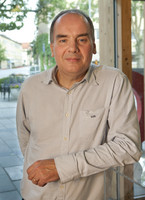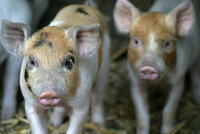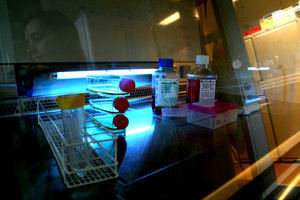Olle Korsgren

The art of correctly replacing what the immune system has destroyed
One day of seeing patients. The next day cutting-edge research in order to improve outcomes in the transplantation of insulin cells, and to develop future treatments of type 1 diabetes with stem cells or with cells from animals. One third of the time seeing patients. The rest of the time research. This is what Olle Korsgren´s long work week looks like.
- First my hobby, research, became my profession and now my profession is also my hobby, says Olle Korsgren who has been working enthusiastically as a chief consultant at Uppsala University Hospital and as Professor of Transplantation Immunology at Uppsala University. He is also one of the scientists working with diabetes researchers from Malmö/Lund in the EXODIAB project.
- I had two choices as a researcher. Either pure basic research, with test tubes and animal experiments in a lab or clinical research and patient contact. I chose the latter, the patients are pushing me back into the mainstream, says Olle Korsgren.
The cure worse than the disease
The major challenge in the transplantation of insulin-producing pancreatic islets is taming the body´s own immune system which otherwise relentlessly attacks and kills any foreign body tissue, even transplanted organs and cells. It was the push into the mainstream which brought him into the field of transplantation and, in particular, how to get the results better.
Only for a small minority
- We can suppress the immune system with drugs but there are so many side effects that for most patients it’s better to continue with insulin rather than taking the medications for rejection, says Olle Korsgren and goes on to say that even if there were an unlimited supply of pancreatic islets, only a small minority of patients would be considered for transplantation.
Not a cure – a treatment
- A small percentage have diabetes severe enough to justify the side effects. These are mainly adults who repeatedly lose consciousness due to low blood sugar.The immunosuppressants have a long list of unwanted effects. The risk of infection is increased, and also the risk of cancer. Blood pressure rises, there is a negative effect on blood lipids and the kidneys are damaged.
- Transplantation is not yet a cure. It is a treatment for patients who have diabetes so severe that it is ruining their lives, says Olle Korsgren and adds:
- It is not an option for children. So far not a single child in Sweden has received new insulin cells from another human.
A fast and devastating attack

Trying to reduce the massive cell death associated with transplantation is another important field of research. Partly the problem is that many pancreatic islets die before they are in place and can receive the necessary oxygen and nutrients. Partly it is the immune system’s fast and devastating attack. Half of the cells are killed within one minute.
- We have tried placing the pancreatic islets in a muscle on the arm, says Olle Korsgren and tells of the dramatic event which led to the idea of muscle instead of injecting the pancreatic islets directly into the blood stream so that they end up in the liver, which has been the standard method.
The islets in the arm
- There was a seven year old girl who had severe inflammation of the pancreas. She was being treated in the intensive care unit at Karolinska University Hospital in Huddinge and her doctors did not think she would survive unless her pancreas was removed, says Olle Korsgren, and says that the girl’s doctors contacted his research group in Uppsala.
- They asked us if we could save her pancreatic islets so that she wouldn’t develop diabetes.
Low-dose insulin support
The inflamed pancreas was removed and transported to the Rudbeck laboratory in Uppsala, where the islets were isolated and prepared before being sent back to the girl for transplantation. She was regarded as being too sick to get the pancreatic islets to her liver, which is why she had them placed in her forearm.
We had to act
- This was more than three years ago and the girl is fine. Her blood glucose control is working well and she only takes a little insulin to support the reimplanted pancreatic islets so that they will not be worn out, says Olle Korsgren.
- The girl presented us with a clinical situation where we had to act, he says.
Today the method has successfully been tested in patients with diabetes. Animal studies also show that pancreatic islets in muscle get faster and better blood supply than in the liver.
A protective capsule
The reason why the results were so good with the girl is that she got her own insulin-producing cells and therefore they were accepted by her immune system.
One way of trying to protect pancreatic islets from the ”alien” is to encapsulate them, camouflaging them from the immune system (see link below).
- We are working on the construction of a capsule. It has to shut out the immune cells but still be able to release the insulin produced within the capsule. In the long run one could imagine adding growth factors and oxygen carriers in the capsule to help the insulin cells find their place, says Olle Korsgren.
- There is a lot of research left to do before the transplantation of pancreatic islets can become a treatment or a cure for a large number of patients, he sums up the situation today.
A donated pancreas arrives
After getting this far the interview is temporarily interrupted. A pancreas from a deceased donor has arrived. It needs to be examined, are the pancreatic islets healthy enough to be used for transplantation, if not they will be used for research. The pancreatic islets also need to be isolated and prepared. Of course Olle Korsgren takes part in this. A moment later he is back.
Stem cells - an option for the future
- Stem cells is a tempting alternative for the future, he continues. They could become a virtually inexhaustible source.
An inexhaustible source
Stem cells have two properties which researchers appreciate. One is that under the proper conditions they continue to divide indefinitely. The second is that the earliest stages, embryonic stem cells, have the ability to develop into any cell of the body.
The extensive research now taking place is about understanding how a stem cell ”knows” it is supposed to develop into a nerve cell, a skin cell or a insulin-producing beta cell, to understand and learn how to guide the cell into becoming a cell of the desired type.
Filter out immature cells
- We also need to be certain that we are able to filter out all the immature stem cells in a cell culture. Otherwise when they are in place they will continue to do what we want them to do when we grow them, which is to divide indefinitely, says Olle Korsgren.
The problem of suppressing the attacks of the immune system still exists in the transplantation of insulin cells developed from stem cells in the laboratory.
- Stem cell therapy for diabetes is several years into the future, says Olle Korsgren.
From animal to human
Another source of insulin-producing cells for transplantation may be cells from animals, known as xenotransplantation. There were high hopes on the method about 20 years ago.
It was the late 1980s, Olle Korsgren was still a doctoral student doing research on the development of the pancreas in pig fetuses.
- I came in contact with a research team in Stockholm, who worked with xenotransplantation. We tried to transplant insulin cells from pig fetuses to a species of mice that spontaneously develop diabetes and the experiments worked out well, says Olle Korsgren, and goes on to say that the pig cells survived in the mouse and that they produced insulin. The decisive step, transplanting from animals to humans was next.
Ten patients with type 1 diabetes received cells from pig fetuses at the same time as they received a new kidney, and therefore still had to take immunosuppressive drugs to protect the kidney.
Risk of new infectious diseases
- It also worked. The beta cells survived, they reacted to the level of glucose in the blood and they produced insulin, although only in small amounts. In principle the concept worked, says Olle Korsgren.
This was during the first years of the 1990s. Olle Korsgren had received his doctoral degree. Research on xenotransplantation was being done around the world. Then came the fears, could it cause new epidemics among humans, transfer infections from animals which humans lacked protection for. The enthusiasm regarding xenotransplantation faded considerably.
Pig cells that cure diabetes

- This has since been investigated very thoroughly and today the scientific community agree that the risk of new infections is, if it exists, very small. Research on xenotransplantation has started again, especially in the US and in Australia, says Olle Korsgren, adding that a lot of work remains before it can be used as a treatment for diabetes and other conditions.
The xeno-reaction even more powerful
- This will not be a possibility for many years yet. We have to learn more about the immune system and how to avoid rejection. The reaction is even more powerful in xenotransplantation, but of course it would be very useful if we could use pig cells to cure diseases.
Hard to outwit the immune system
We would not survive without an immune system, we would succumb to attacks by bacteria, viruses and parasites but in transplantation our own defence becomes an enemy. It needs to be slowed down to make sure the graft is not repelled, but in a controlled manner so that it can continue to protect the body against invaders.
- The immune system is very effective and it is hard to outwit in a way that ensures that the benefits outweigh the risk to the patient, says Olle Korsgren.
Working with people
That he would become a doctor and a scientist was not obvious.
- No, I had difficulty choosing. Part of the reason why I studied natural sciences was that I wanted to keep my options open since I didn’t really know what I wanted to do.
After finishing school he started studying to become a pharmacologist but dropped out. Instead he went to medical school. Unlike many scientists in the natural sciences he was never interested in ornithology or collecting butterflies and birds’ eggs as a child.
- Nature didn’t interest me much, the human being did. I had finally figured out that I wanted to work with people.
The job is a hobby
While he was in medical school he started doing research on weekends and summer holidays. Science attracted him and after getting his medical degree he began work on his thesis which was completed 1991.
Nine years later he was appointed Professor of Transplantation Immunology at Uppsala University where he has stayed since.
Luckily his work is also his hobby. With a 60 to 80 hour long work week, and a big family, two of his six children still living at home, where would he find time for any interests outside his work.
